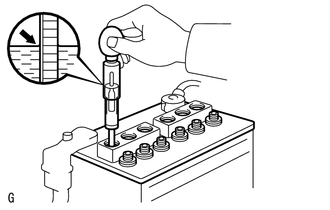Toyota Venza: On-vehicle Inspection
ON-VEHICLE INSPECTION
PROCEDURE
1. CHECK BATTERY CONDITION
NOTICE:
If the battery is weak or if the engine is difficult to start, perform the following procedure.
(a) Check the battery for damage and deformation. If severe damage, deformation or leakage is found, replace the battery.
(b) Check the electrolyte quantity of each cell.
|
(1) For maintenance-free batteries:
|
|
|
(2) For non-maintenance-free batteries:
Standard Specific Gravity: 1.25 to 1.29 at 20°C (68°F) If the electrolyte quantity is above the lower line, check the battery voltage when cranking the engine. If the voltage is less than 9.6 V, recharge or replace the battery. HINT: Before checking the battery voltage, turn off all the electrical systems (headlights, blower motor, rear defogger, etc.). |
|
(c) Check the voltage.
(1) Turn the ignition switch off and turn on the headlights for 20 to 30 seconds. This will remove the surface charge from the battery.
(2) Measure the battery voltage according to the value(s) in the table below.
Standard Voltage:
|
Tester Connection |
Condition |
Specified Condition |
|---|---|---|
|
Positive (+) terminal - Negative (-) terminal |
20°C (68°F) |
12.5 to 12.9 V |
HINT:
If the result is not as specified, charge the battery.
2. CHECK BATTERY TERMINAL
(a) Check that the battery terminals are not loose or corroded.
If a terminal is loose or corroded, tighten or clean the terminal.
Torque:
Positive (+) Battery Terminal :
6.9 N·m {70 kgf·cm, 61 in·lbf}
Negative (-) Battery Terminal :
6.9 N·m {70 kgf·cm, 61 in·lbf}
3. CHECK FUSES
(a) Measure the resistance of each fuse for the charging system.
HINT:
The fuses shown in the System Diagram are related to the charging system.
Standard Resistance:
Below 1 Ω
- If any of the results is not as specified, replace the fuse(s) as necessary.
4. INSPECT V-RIBBED BELT
.gif)
5. INSPECT GENERATOR WIRING
(a) Visually check the generator wiring.
(1) Check that the wiring is in good condition.
6. CHECK FOR ABNORMAL NOISES
(a) Listen for abnormal noises from the generator.
(1) Check that no abnormal noises are heard from the generator while the engine is running.
7. INSPECT CHARGE WARNING LIGHT CIRCUIT
(a) Turn the ignition switch to ON. Check that the charge warning light comes on.
(b) Start the engine and check that the light goes off.
If the light does not operate as specified, troubleshoot the charge warning light circuit.
8. INSPECT CHARGING CIRCUIT WITHOUT LOAD
|
(a) Connect a voltmeter and an ammeter to the charging circuit as follows. Text in Illustration
(1) Disconnect the wire from terminal B of the generator and connect it to the negative (-) lead of the ammeter. (2) Connect the ammeter positive (+) lead to terminal B of the generator. (3) Connect the voltmeter positive (+) lead to the positive (+) terminal of the battery. (4) Ground the voltmeter negative (-) lead. |
|
(b) Check the charging circuit.
(1) Keep the engine speed at 2000 rpm and check the readings on the ammeter and voltmeter.
Standard Current:
10 A or less
Standard Voltage:
13.2 to 14.8 V
If the result is not as specified, replace the generator.
HINT:
If the battery is not fully charged, the ammeter reading will sometimes be more than the standard current.
9. INSPECT CHARGING CIRCUIT WITH LOAD
(a) With the engine running at 2000 rpm, turn the high beam headlights on and turn the heater blower switch to the "HI" position.
(b) Check the reading on the ammeter.
Standard current:
30 A or more
If the ammeter reading is less than the standard current, repair the generator.
HINT:
If the battery is fully charged, the indication will sometimes be less than the standard current. If this is the case, add more electrical load (operate the wipers, rear window defogger, etc.) and check the reading on the ammeter again.
 Charge Warning Light Comes ON while Driving
Charge Warning Light Comes ON while Driving
PROCEDURE
1.
CHECK LOCK FUNCTION OF GENERATOR CLUTCH PULLEY
(a) Check the lock function with the pulley installed in the vehicle.
(1) Visually check that the rotor i ...
 Noise Occurs from Generator while Engine is Running
Noise Occurs from Generator while Engine is Running
PROCEDURE
1.
CHECK LOOSENESS OF V-RIBBED BELT
(a) Check the tension of the belt by pushing it down with a finger.
OK:
The tension of the belt is enough.
NG ...
Other materials about Toyota Venza:
EVAP System
RELATED DTCS
DTC No.
Monitoring Item
See page
P043E
Reference orifice clogged (built into canister pump module)
P043F
Reference orifice high-flow (built into ...
Inspection
INSPECTION
PROCEDURE
1. INSPECT INTAKE AIR CONTROL VALVE (for ACIS)
(a) Inspect the diaphragm.
(1) Using a vacuum pump, apply a vacuum of 60 kPa (450 mmHg, 17.7 in.Hg)
or higher to the diaphragm chamber. Wait for 1 minute and check that the ...
If your vehicle has to be stopped in an emergency
Only in an emergency, such as if it becomes impossible to stop the vehicle
in the normal way, stop the vehicle using the following procedure:
Steadily step on the brake pedal
with both feet and firmly depress it.
Do not pump the brake pedal repeatedly a ...
0.1246

.png)

.png)